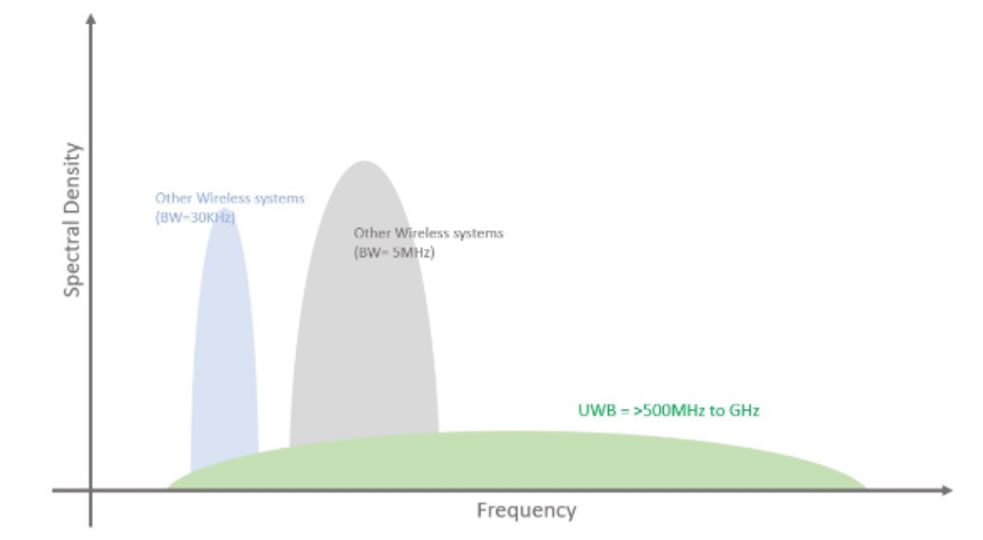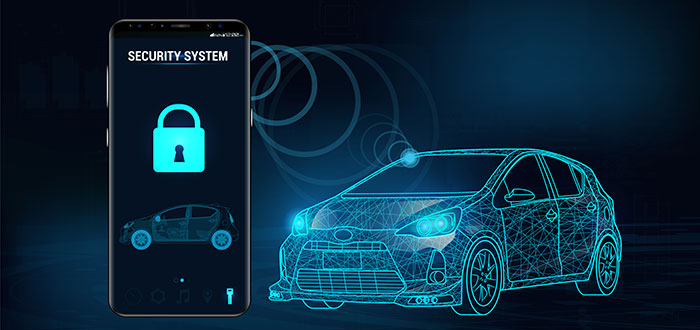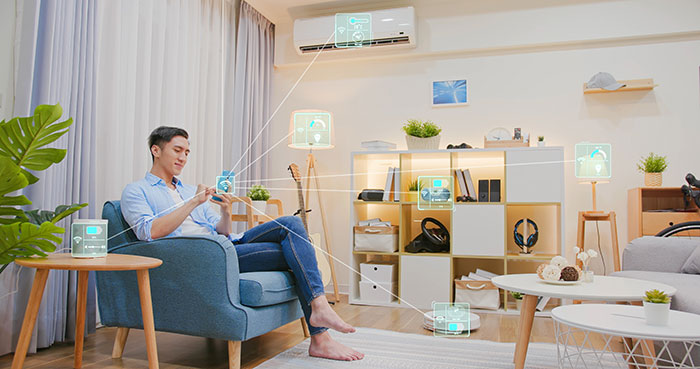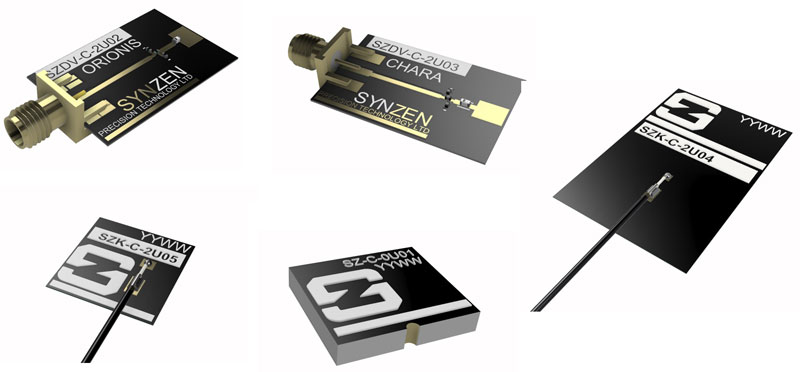Article Date: 05 September 2023
It’s taken its time, but ultra-wideband (UWB) has finally arrived. After dragging its heels for several decades, UWB is finally seeing the light of day in a host of consumer and industrial devices and applications. It now looks set to be widely developed and join other popular wireless standards such as Wi-Fi, Bluetooth, and GNSS.
Ultra-wideband is a wireless protocol that works at high frequencies and it’s able to transmit large amounts of data over short distances. But what's particularly special about UWB, is that this technology allows for highly precise location tracking and can be used to communicate with other devices even when they are not in direct line of sight.
As its name suggests, it operates in wide bandwidths of 500MHz (or more) currently within the range of 3.1 to 10.6 GHz. Because of its wide bandwidth, it’s able to use a low transmit power - which also greatly reduces the chance of interfering with signals from narrowband wireless systems.

As for speed, ultra-wideband is no slouch. Data rates of up to 1Gbps are achievable. Not as fast as Wi-Fi; Wi-Fi 6 has a theoretical maximum speed of up to 10 times faster than this – but UWB has much quicker data rates than other wireless technologies like Bluetooth and NFC.
However, while its data rates are significantly higher than Bluetooth and NFC, it can’t compete with Wi-Fi and cellular technologies. So, although UWB was originally touted as a potential high bandwidth technology, Wi-Fi now dominates that area of wireless communication.
Speed is not ultra-wideband's trump card; it is UWB’s ability to accurately pinpoint other devices that makes it destined to become the popular choice for tracking and location technology. And choosing the right ultra-wideband antenna for an electronic device is important because the antenna plays a critical role in the performance of any device.
Table of Contents
UWB works a bit like sonar, but UWB uses short pulses of radio waves - around 500 million a second - rather than sound waves. These pulses help the receiver to triangulate the position and movement of an object through what’s known as “ranging”.
To perform ranging, one UWB device sends out a series of these low-power radio pulses, which are received by the other device. By measuring the time it takes for these pulses to travel from the transmitting device to the receiving device - known as Time of Flight (ToF) - the distance between the two devices can be calculated.
UWB technology can also use other information such as angle of arrival and time difference of arrival to help determine the position and relative movement of devices. Using these multiple techniques in combination further improves the accuracy of UWB’s location tracking.
Overall, ranging is an important part of how UWB technology works, as it enables UWB devices to communicate with each other and determine their relative positions with high accuracy. This is essential for a wide range of applications, including indoor positioning, tagging, digital keys, and other location-based services.
UWB is not new. Like all wireless communications, its birth can be traced back to the pioneering work of people like Heinrich Hertz and Guglielmo Marconi. In the 20th Century, there was some development of UWB patents and potential uses, but UWB’s growth in the commercial sector was largely stifled and the technology found its way mainly into military applications and equipment.
A major reason for its slow growth commercially was regulatory organisations, such as the Federal Communication Commission (FCC), who were worried about its potential effect on existing wireless technologies. It's only in the last two decades that the FCC started to allow commercial development in the wake of the IEEE 802.15.4 standard.
That has taken a further leap forward recently when IEEE 802.15.4z - which specifically focuses on UWB - was unveiled in 2020. This latest standard has further improved the accuracy of ranging and also features the inclusion of ciphered messages and encryption technology to greatly increase security. Digital keys are now being developed, as UWB is proving to be particularly robust against car theft and other forms of hacking.

Organisations like the Car Connectivity Consortium (CCC), the UWB Alliance, and the FiRa Consortium have been set up to encourage the expansion of UWB. They continue to push regulatory bodies to ease restrictions on the development of UWB - restrictions which sometimes force developers to jump through hoops to get the green light for projects.
Companies like Apple and Samsung are already unlocking the potential of UWB technology by including it in their recent smartphones. New tagging devices like Apple’s Airtags and Samsung’s Smart Tags have led the commercial charge of UWB.
And the roll out of many other electronic devices and applications using UWB is gathering pace. Other smartphone manufacturers like Google, Xiaomi, and Oppo have also released devices with UWB. As it finds its way into more and more smartphones, we’re likely to see a huge increase in the number of consumer-focused devices and applications as developers race to exploit its potential.
UWB is being widely explored in the automotive industry - especially in the development of secure digital keys. Companies such as BMW are already employing UWB - their iX model turns on its lights and unlocks the car as owners approach the car without the need to take their smartphone out of their pocket.
The adoption of UWB is set to grow in other sectors such as the Internet of Things (IoT). Because of UWB's precision in tracking people and objects, it can be used to improve the effectiveness of home automation systems, allowing a smart home to automatically adjust lighting, temperature, or other settings.
And because ultra-wideband is highly directional, any UWB-enabled device could be easily and accurately controlled with a smartphone.

What's particularly cool, is that the smartphone could display a custom interface for each device. For example, by pointing at a light, a unique interface would automatically appear on the smartphone through which the user could change things like the light level with a slider or maybe use a colour wheel.
In the media, there have been some recent high-profile use cases regarding the use of ultra-wideband technology. The following two examples just go to show how versatile UWB is, and how it has the potential to become a ubiquitous technology in the near future.
While we've started to get used to video-assisted refereeing (VAR), football referees are going to be getting a lot more help in the future courtesy of ultra-wideband innovations. In the 2022 FIFA World Cup in Qatar, the competition saw the introduction of UWB technology when sensors were fitted inside every football to give precise data on where the ball was at any time and transmit that data in real time.
UWB's ability to precisely track people and objects - even in challenging environments such as dense urban areas or buildings - has the potential to be a useful tool for contact tracing and social distancing in the continued fight against COVID-19.
One major caveat is that UWB’s ability to track so effectively also raises privacy and security issues. Like most technology, as much as it can enhance society, there is always the possibility of it being abused.
Ultra-wideband is compatible with other wireless technologies in the sense that it can be used in conjunction with these technologies to provide additional functionality or to improve performance. For example, UWB can be used in combination with Wi-Fi or Bluetooth to provide improved location accuracy or to enable high-speed data transfer. And while UWB is great for indoor tracking, devices will still need GNSS support to reveal their global location.
So, rather than ultra-wideband replacing existing wireless systems, UWB is actually a versatile technology that can work seamlessly alongside GNSS, Wi-Fi, Bluetooth, NFC, and RFID to provide additional functionality or to improve performance.
As UWB technology becomes more widespread, we will increasingly begin to see new applications. UWB may be used in settings such as:
The application of ultra-wideband technology remains in its infancy — so although it is already clear that the future of this technology is exciting, we’ll all have to wait to see the fascinating use cases that we may one day take for granted.

Truly, the potential for products, services, and applications of UWB technology is limitless. Therefore, it is important to carefully consider the specific requirements of the device and choose an ultra-wideband antenna that is well-suited for its intended application. This can help ensure that the device performs at its optimal level and meets the desired performance goals.
At Synzen Precision Technology, we have a comprehensive range of ultra-wideband antennas, utilising various technologies, that cover the full frequency range of 3.1 to 10.6 GHz. We have many different antennas to choose from depending on the application and environment. Click here to take a look at our UWB product page.
Also, if you have any ideas or potential projects that may require a custom solution, or just need to know what antenna would be the best fit and how it could be integrated into your device, our team of experienced engineers at Synzen are always more than happy to chat with you. Click here to arrange a free consultation.
If you would like to get in touch with us, please do so using the short form .
4f, No. 58, Zhouzi St, Neihu District, Taipei City, Taiwan 114
Contact Us
Please fill in the short form below for any enquiries.